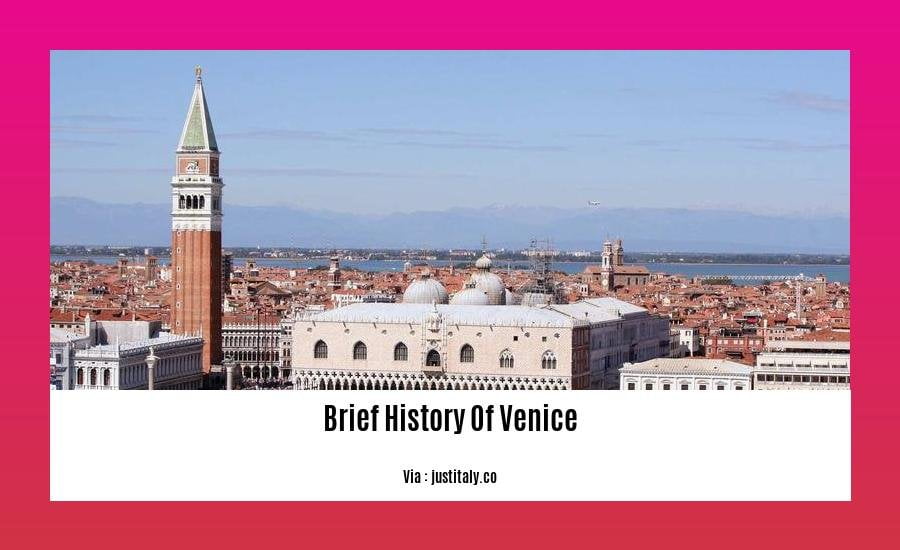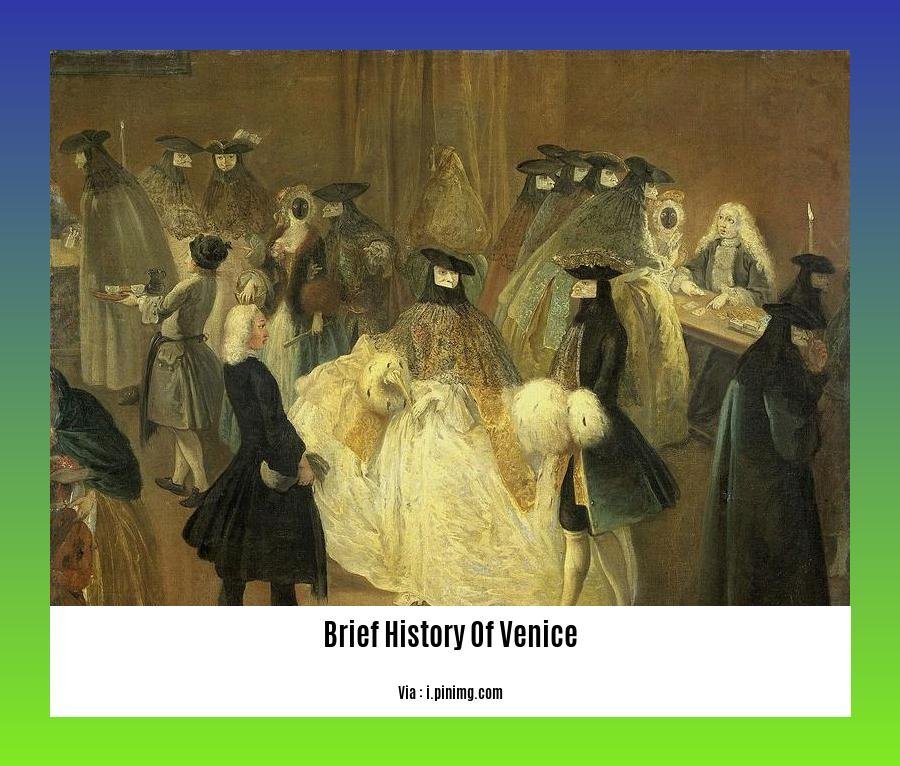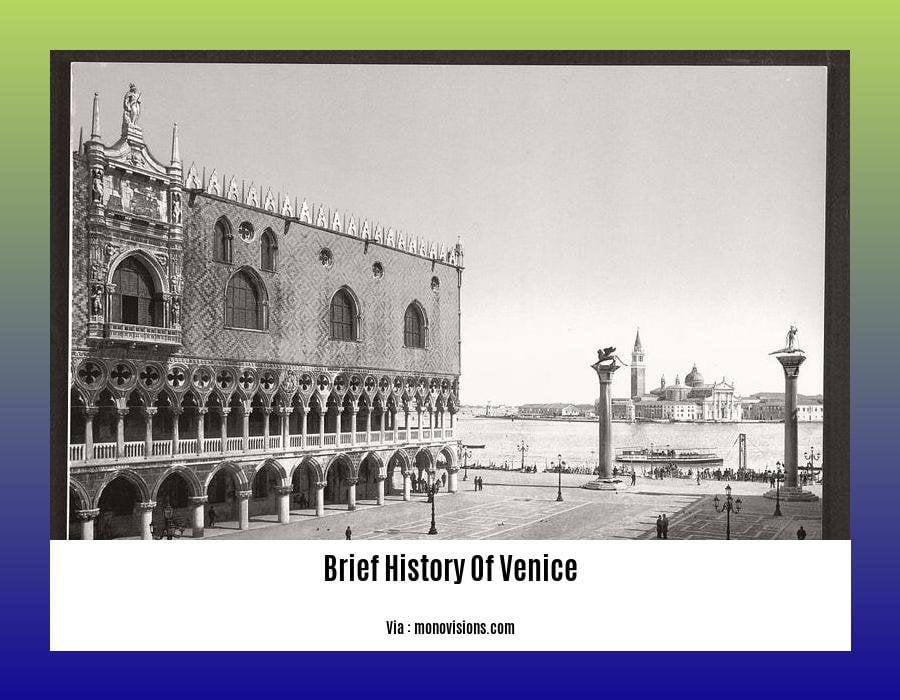In the heart of a tranquil lagoon, where shimmering waters dance with the gentle whispers of history, lies a city of unparalleled beauty and timeless allure—Venice. Embark on a captivating journey through the annals of this remarkable city, where every stone and canal holds secrets waiting to be unveiled. [Delving into the Enchanting Past: A Brief History of Venice] unveils the rich tapestry of a city that has captivated hearts and minds for centuries, inviting you to witness the rise and fall of empires, the birth of artistic masterpieces, and the echoes of a glorious past that linger in every corner.
Key Takeaways:
- Venice was founded in the 6th century CE by Italian refugees fleeing from invaders.
- The city is built on 119 islands in the Venetian Lagoon, separated from the Adriatic Sea by a long strip of land.
- Venice became a powerful seafaring nation, trading and fighting in the Mediterranean, reaching its peak in the Middle Ages.
- In 1797, Venice fell under Napoleon’s rule and began to decline.
A BRIEF HISTORY OF VENICE

Venice, a maritime marvel adorned with canals and architectural wonders, is steeped in a rich history spanning centuries. Founded in the 6th century by Italian refugees seeking refuge from invading forces, this lagoon city is a testament to resilience and innovation.
The Rise of a Maritime Empire
Venice’s strategic location at the head of the Adriatic Sea fueled its transformation into a prominent maritime power. The city’s control over trade routes between the East and West brought immense wealth and influence, propelling it to become a formidable force in the Mediterranean.
A Republic on the Lagoon
Venice’s unique political structure, a republic ruled by a doge, ensured stability and continuity. The Doge, elected by the nobility, served as the city’s leader, guiding Venice through centuries of prosperity and power.
Cultural Crossroads and Artistic Splendor
Venice’s status as a trading hub attracted people from diverse cultures, leading to a vibrant exchange of ideas and artistic influences. This confluence of cultures gave birth to the city’s unique architectural style, blending Byzantine, Gothic, and Renaissance elements, creating masterpieces like St. Mark’s Basilica and the Doge’s Palace.
Decline and Fall
The 18th century marked a period of decline for Venice, weakened by the rise of rival maritime powers and the changing trade routes. In 1797, Napoleon Bonaparte conquered the city, marking the end of the Venetian Republic.
Legacy of a City of Canals
Despite the decline, Venice’s captivating charm endures. Its canals, gondolas, and iconic landmarks continue to attract millions of visitors each year, eager to experience the allure of a city that has stood the test of time.
Do you want to know about the fascinating past of the world’s most populous black nation? Click here to learn more about the brief history of Nigeria from 1960 till date.
Would you like to learn more about the past of one of the most visited cities in the world? click here to know more about the brief history of venice italy.
Are you a big fan of baseball and want to know more about the California Angels? Click Here to read about the California Angel Hat History.
Controlled vast trading empire stretching from the Middle East to Northern Europe, becoming one of the wealthiest cities in Europe.
Venice’s ascent to prominence was closely intertwined with its strategic position, enabling it to establish a robust trading network that stretched from the Middle East to Northern Europe. This network encompassed a vast array of goods, including spices, silks, and precious metals. Venice’s merchants ventured into distant lands, forging alliances and establishing trading posts, which contributed to the city’s immense wealth and prosperity.
The city’s unique political structure played a significant role in its trading success. Venice was governed by an elected Doge, a system that ensured stability and continuity. This enabled the city to maintain a consistent trade policy, fostering trust and confidence among its trading partners.
Venice’s status as a trading hub also led to a vibrant exchange of ideas and artistic influences. The city became a melting pot of cultures, with merchants, artists, and scholars from across the globe converging to share knowledge and expertise. This exchange enriched Venice’s cultural landscape, contributing to its unique blend of Byzantine, Gothic, and Renaissance architectural styles.
Key Takeaways:
- Venice’s strategic location at the head of the Adriatic Sea transformed it into a prominent maritime power.
- The city’s vast trading network stretched from the Middle East to Northern Europe, encompassing a wide range of goods.
- Venice’s wealth and prosperity were largely attributed to its successful trading endeavors.
- The city’s unique political structure ensured stability and continuity, fostering trust among trading partners.
- Venice’s status as a trading hub led to a vibrant exchange of ideas and artistic influences, enriching its cultural landscape.
Sources:
[1] https://www.britannica.com/topic/history-of-Europe/Trade-and-the-Atlantic-Revolution
[2]
Unique System of Government: The Venetian Republic, Enduring for Over a Millennium

Picture a city rising from the depths of a lagoon, a testament to human ingenuity and resilience. Venice, the Queen of the Adriatic, emerged as a unique and powerful maritime republic, with a system of government that defied the norms of its time. This fascinating city-state thrived for over a thousand years, leaving an indelible mark on the pages of history.
A Delicate Balance of Power
The Venetian Republic stood out for its intricate system of government. In a world dominated by monarchs and empires, Venice embraced a unique model of governance that shared power among its citizens. At the helm of the republic was the Doge, an elected official whose authority was carefully balanced by various councils and assemblies. This complex structure ensured that no single individual could amass absolute power, fostering a delicate equilibrium that served Venice well for centuries.
The Grand Council: A Bastion of Democracy
The heart of Venetian governance lay in the Grand Council, a body composed of representatives from across the city’s noble families. This assembly held immense power, electing the Doge, passing laws, and overseeing the republic’s finances and foreign policy. Membership in the Grand Council was highly coveted, and only those who met stringent eligibility criteria could participate. This system ensured that Venice’s ruling elite remained accountable to the wider citizenry.
Stability and Continuity: The Cornerstones of Success
Venice’s unique system of government provided remarkable stability and continuity. Unlike many of its contemporary states, the republic was not plagued by dynastic disputes or power struggles. The election of the Doge for a lifetime term ensured a smooth transition of power, while the involvement of a broad spectrum of citizens in governance fostered a sense of shared responsibility and common purpose. This stability allowed Venice to flourish economically, culturally, and politically, establishing itself as a major player in the Mediterranean and beyond.
Key Takeaways:
- Venice’s unique system of government, characterized by a delicate balance of power shared among its citizens, contributed to its stability and endurance for over a thousand years.
- The Grand Council, composed of representatives from the city’s noble families, played a crucial role in electing the Doge, passing laws, and overseeing the republic’s affairs.
- The system fostered a sense of shared responsibility and common purpose among Venice’s citizens, allowing the republic to thrive economically, culturally, and politically.
Sources:
- The Republic of Venice
- The History of Venice
Left a legacy of stunning architecture, artwork, and cultural traditions that continue to captivate visitors today.
Venice’s past is a grand tale, adorned with tales of power, wealth, and artistic prowess. In the tapestry of time, this once-mighty maritime republic left an indelible mark on the canvas of history, leaving a legacy of stunning architecture, artwork, and cultural traditions that continue to captivate visitors today.
Imagine walking through the labyrinthine alleyways of Venice, where every corner whispers a secret from the past. The city’s canals, like liquid ribbons, meander through the heart of the city, reflecting the glory of palaces and churches that line their banks.
Venice’s architectural wonders are a testament to the ingenuity and artistry of its people. St. Mark’s Basilica, a masterpiece of Byzantine and Gothic styles, stands as a symbol of Venice’s maritime prowess. The Doge’s Palace, once the seat of power for the Venetian Republic, awes with its intricate carvings and opulent grandeur.
The city’s artistic legacy is equally impressive. Titian, Tintoretto, and Veronese, masters of the Venetian Renaissance, left behind a treasure trove of paintings that adorn the walls of Venice’s churches and museums. Their vibrant colors and expressive brushstrokes capture the essence of a city pulsing with life and creativity.
Venice’s cultural traditions are a vibrant tapestry woven from the threads of history. The Carnival of Venice, a riot of masks and costumes, harkens back to a time of revelry and intrigue. Glassblowing, a craft perfected by Venetian artisans, transforms molten glass into exquisite chandeliers, vases, and sculptures that shimmer with a thousand colors.
Venice’s legacy extends beyond its physical beauty. The city’s spirit of innovation and resilience left an imprint on the world. From its pioneering role in trade and exploration to its unique system of government, Venice was a beacon of progress in a world often shrouded in darkness.
Key Takeaways:
- Venice’s strategic location at the head of the Adriatic Sea transformed it into a maritime powerhouse.
- Venice’s unique political structure, led by an elected Doge, ensured stability and continuity.
- Venice’s wealth and power were fueled by trade, particularly in salt and other commodities.
- Venice’s military strength, especially its navy, played a crucial role in securing and maintaining its maritime dominance.
- Venice’s decline began in the 17th century due to the rise of rival maritime powers and the discovery of new trade routes.
- Despite its decline, Venice remained a popular tourist destination and a source of inspiration for artists and writers.
- Today, Venice is a UNESCO World Heritage Site and one of the most popular tourist destinations in the world.
Venice, a city built on water, has weathered the storms of time, emerging as a symbol of enduring beauty and cultural significance. Its legacy, etched in stone, canvas, and tradition, continues to enchant visitors from around the world, leaving them forever captivated by the magic of this enchanting city.
Sources:
History of Venice: Rise and Fall of the Venetian Republic
11 Fun Facts About Venice (You Probably Didn’t Know)
FAQ
Q1: What factors contributed to Venice’s rise as a maritime power?
A1: Venice’s strategic location on the Adriatic Sea provided easy access to trade routes, and its strong navy allowed it to control and protect its maritime trade. Venice’s skilled shipbuilders and navigators also contributed to its success as a seafaring nation.
Q2: How did Venice’s maritime power and trade influence its economy and culture?
A2: Venice’s maritime activities brought immense wealth and prosperity to the city. Trade with the East brought in luxury goods such as spices, silks, and jewels. This wealth supported the development of Venetian art and architecture, making Venice a center of artistic and cultural achievement.
Q3: What were the key events that led to Venice’s decline in the 17th century?
A3: Venice faced numerous challenges in the 17th century, including the rise of the Ottoman Empire, which disrupted trade routes to the East. The discovery of new trade routes to the Americas and the East Indies via the Atlantic Ocean further diminished Venice’s importance as a maritime power. Additionally, the city was hit by a series of devastating plagues, which weakened its population and economy.
Q4: Despite its decline, why did Venice remain a popular tourist destination and a source of inspiration for artists and writers?
A4: Even after its decline, Venice retained its unique charm and beauty, attracting visitors from around the world. Its canals, architecture, and art continued to inspire artists and writers, who saw Venice as a symbol of a bygone era. Venice’s rich history, artistic treasures, and stunning scenery made it a popular destination for travelers seeking a glimpse into the past.
Q5: What are some of the legacies of Venice’s maritime empire?
A5: Venice’s maritime empire left a lasting impact on the Mediterranean region and beyond. Its trading networks and cultural influences spread throughout Europe, the Middle East, and North Africa. Venice’s system of government and administration also served as a model for other city-states and republics. Additionally, Venice’s maritime expertise and innovations in shipbuilding and navigation contributed to the development of maritime technology and exploration.
- Old Mexico Map: Border Shifts 1821-1857 - April 19, 2025
- Blindness Doesn’t Limit: Popular Blind People’s Inspiring Success Stories - April 19, 2025
- Discover Famous Chinese People: A Deep Dive into History’s Impact - April 19, 2025

![[Brief History of Venice Italy]: A Journey Through Time and Wonders brief-history-of-venice-italy_2](https://www.lolaapp.com/wp-content/uploads/2023/12/brief-history-of-venice-italy_2-150x150.jpg)

![[Phrase Match] Embracing Evolution: A Journey Through Contemporary Dance History contemporary-dance-history_2](https://www.lolaapp.com/wp-content/uploads/2023/12/contemporary-dance-history_2-150x150.jpg)












